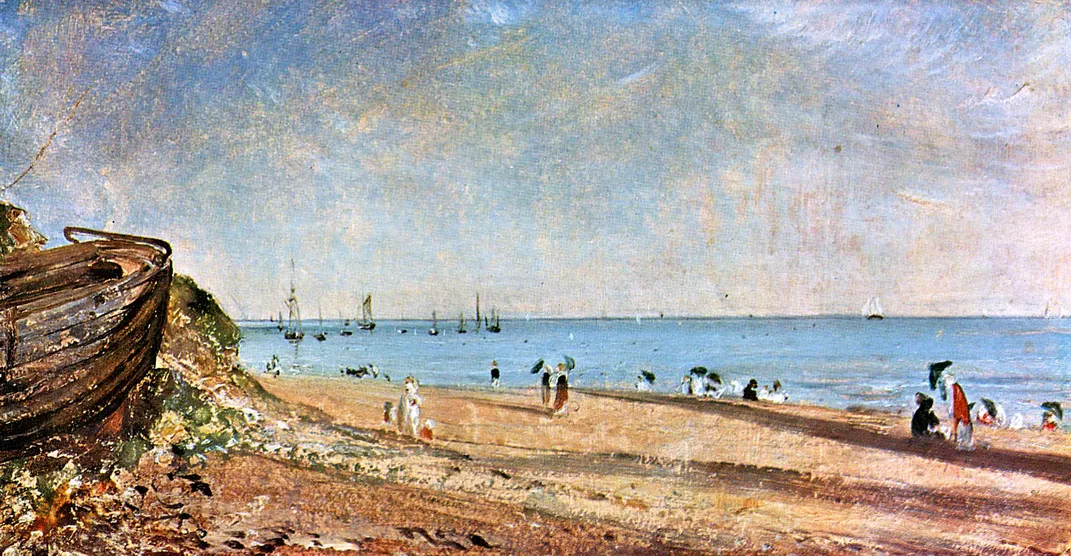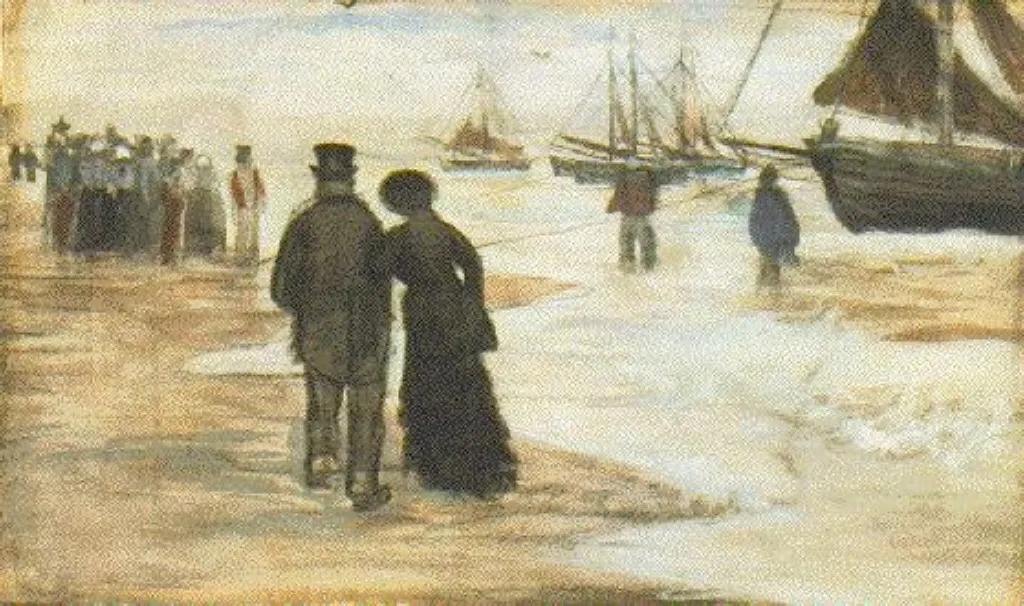Inventing the Beach: The Unnatural History of a Natural Place
The seashore used to be a scary place, then it became a place of respite and vacation. What happened?
/https://tf-cmsv2-smithsonianmag-media.s3.amazonaws.com/filer/57/57/5757a8b8-1d7b-407f-b24f-984d198a468b/beach-at-boulogne-1869.jpg)
This summer, millions of Americans will flock to the beach, taking advantage of long days, warm weather and the end of classes. From Coney Island and Venice Beach to the shores of Lake Michigan and the Gulf Coast, bags will be packed, coolers dragged, sunscreen slathered, and sandcastles built. Similar scenes will be repeated around the world. In Rio de Janeiro, Sydney, Barcelona, and Beirut, children will be splashing in the waves while sunbathers doze on the sand. A day at the beach is a cultural ritual.
But it hasn’t always been this way. From antiquity up through the 18th century, the beach stirred fear and anxiety in the popular imagination. The coastal landscape was synonymous with dangerous wilderness; it was where shipwrecks and natural disasters occurred. Where a biblical flood engulfed the world. In classical mythology, the wrath of the ocean is a major theme; the beach a bearer of misfortune. Tears flow on Homer’s shores while monsters lurk in the surf: Scylla surrounded by her barking dogs and Charybdis swallowing the sea only to spit it out again in a boiling whirlpool. “With few exceptions,” writes Alain Corbin, professor emeritus of modern history at Paris’s Sorbonne University and author of The Lure of the Sea: The Discovery of the Seaside in the Western World, 1750-1840, “the classical period knew nothing of the attraction of seaside beaches, the emotion of a bather plunging into the waves, or the pleasures of a stay at the seaside.”
The specter of Leviathan or Kraken gave the beach its threatening aura, but so did real hazards that arrived on the shore: pirates and bandits, crusaders and colonizers, the Black Death and smallpox. No wonder Dante’s third circle of hell is lined with sand. On the beach, terror strikes Robinson Crusoe, the first of many castaways to confront destiny on the sand. In Western literature, the shoreline has served as a boundary; the beach the symbolic edge of the unknown.
How was the beach transformed from perilous place to preferred vacation destination — its white sand and rolling waves becoming the ultimate landscape of leisure? The modern embrace of the beach for the purposes of health and hedonism, recreation and retreat, came with the rise of urban, industrial society. The European “discovery” of the beach is a reminder that human ideas about nature have changed over time — with real consequences for the environment and the world.

Around the mid-18th century, according to Corbin, European elites began touting the curative qualities of fresh air, exercise and sea bathing. Especially in Britain, home of the Industrial Revolution, aristocrats and intellectuals became preoccupied with their own health and hygiene. They viewed workers, whose numbers were multiplying in factories and new industrial towns, as strengthened through labor. By comparison, the upper classes seemed fragile and effete: lacking in physical prowess and destined for decline. The notion of the “restorative sea” was born. Physicians prescribed a plunge into chilly waters to invigorate and enliven. The first seaside resort opened on England’s eastern shore in the tiny town of Scarborough near York. Other coastal communities followed, catering to a growing clientele of sea bathers seeking treatment for a number of conditions: melancholy, rickets, leprosy, gout, impotence, tubercular infections, menstrual problems and “hysteria.” In an earlier version of today’s wellness culture, the practice of sea bathing went mainstream.
Corbin draws on art, poetry and travel literature, as well as medical and scientific writing, to show how Romantic sensibilities aided this process. Beginning with Kant and Burke, theories of the sublime extolled nature for its power to generate awe and terror. It was Romantic writers and artists at the turn of the 19th century who added emotion and wonder to the act of strolling along the beach or watching the tide turn. The coastal landscape, once dangerous and deadly, became a site of transformative experience, where the individual was immersed in nature. The beach held the promise of self-discovery. From the shore, J. M. W. Turner and Caspar David Friedrich painted rugged vistas with expressive intensity, creating a new pictorial subject: the seascape. The term, according to a Google Ngram graph, wasn’t used until 1804.
Tracing this remarkable turnaround, “the irresistible awakening of a collective desire for the shore,” Corbin concludes that by 1840, the beach meant something new to Europeans. It had become a place of human consumption; a sought-after “escape” from the city and the drudgery of modern life. The rise of trains and tourism facilitated this cultural and commercial process. Travel became affordable and easy. Middle-class families took to the shore in ever-increasing numbers. In sailors’ jargon, “on the beach” once connoted poverty and helplessness; being stranded or left behind. Now it conveyed health and pleasure. The term “vacation,” once used to describe an involuntary absence from work, was now a desired interlude.

“For better and worse,” the British gave modern tourism to the world, writes John K. Walton, a historian at the University of the Basque Country in Spain, and author of The British Seaside: Holidays and Resorts in the Twentieth Century. Like “factory industry, steam power, modern means of transport and other innovations of the Industrial Revolution,” the seaside resort was a British export, one that originated in the coastal towns of Scarborough, Margate, and Brighton. Over the course of the 1800s, the phenomenon made its way across Europe to Normandy, southwestern France, Italy, parts of Scandinavia, and northern Germany, bringing with it the cult of health and sociability. In Buddenbrooks, Thomas Mann’s intergenerational epic, seaside gatherings of family and friends on the Baltic seem as elemental as the rocks on the shore. But the opposite was true; Europe’s 19th-century beaches and the societies that took to them were transformed by a relentless tide of change. On the Baltic, the Adriatic, and later the Mediterranean and Atlantic, the arrival of the modern masses remade the landscape, reconfiguring old towns and creating new ones. Jane Austen’s Sandition, her final, unfinished novel, satirizes the fashionable beach town with its sublime shoreline as a capitalist distortion; the end of normal life in a traditional fishing community.
“It happened in phases,” says John Gillis, professor emeritus of history at Rutgers University and author of The Human Shore: Seacoasts in History. “The seashore went from being a source of food and where journeys began and ended, to a site of amusement and recreation. Eventually we got to Coney Island and the sport side of the beach: surfing, and so forth.” The problem with all this, Gillis explains, is that “the beach was popularized as a non-place. It was denatured even as it was reconstructed as the purest expression of nature.” In Europe, the beach entered the collective imagination as an escape or a getaway; a retreat from modernity. It was “created ex nihilo” and cordoned off from human activity. “Nothing is more epic than the sea,” wrote Walter Benjamin in 1930, invoking timeless, universal qualities. The beach’s appeal lay in this pristine emptiness; a lack of history and sense of place. “Unlike the countryside,” explains Jean-Didier Urbain, professor of sociology at the University of Paris-Descartes and an expert on tourism cultures, “the beach is not so much a place of return as a place of new beginnings. . .It is a tabula rasa, a blank slate, an abstraction.” These modern meanings have deprived the shore of its own intrinsic value, says Gillis. The consequences for the environment have been dire.
Writing in The New York Times two years ago, Gillis shined a spotlight on a global crisis. Despite modern illusions of timelessness and permanence, “75 to 90 percent of the world’s natural sand beaches are disappearing,” he noted, “due partly to rising sea levels and increased storm action, but also to massive erosion caused by the human development of shores.” Gillis described seaside rituals that have more to do with ecological disaster than leisure: governments importing sand from overseas to satisfy tourist expectations and dump trucks filling in barren stretches of the U.S. Eastern Seaboard. Today, fully one-half of the world’s people live within 60 kilometers (37 miles) of an ocean. Coastal populations have increased, says Gillis, 30 percent in the last 30 years, and the figures are expected to soar in the next decade. Beachside properties are among the most valuable in the world, and while coasts have become the most desirable places to live, they are also highly vulnerable habitats. “Every year governments around the world spend billions,” notes Gillis, “trying to ‘fix’ their coasts to make them conform to the lines they have drawn in the sand.” The imperiled state of the world’s beaches is not only an ecological problem, but also a cultural one. “The beach needs to be reincorporated into nature as a natural phenomenon,” Gillis maintains.
Gillis and other scholars are trying to give the shore a history. In doing so, they are challenging the image of the beach in the popular imagination as an empty, eternal place. History has always been a terrestrial discipline, conceived in the interests of new nation-states, but a growing area of research focuses on the significance of the seas for modern society. The rise of maritime history, observes Gillis, is part of a larger scholarly shift from land to sea. Anthropologists began on islands, but are now studying the waters between them. Geographers and archaeologists have moved offshore to examine human interaction with the oceans. Steve Mentz, an English professor at St. Johns University in New York and author of Shipwreck Modernity: Ecologies of Globalization, 1550-1719, refers to “the blue humanities” to describe these developments. The world’s water, once left to scientists, is now recognized as having cultural and social meaning.

Still, the beach isn’t quite the same as the sea, as Rachel Carson suggested in The Sea Around Us, a lyrical natural history of the world’s oceans. “The boundary between sea and land is the most fleeting and transitory feature of the earth,” Carson wrote. This elusiveness helps explain why the beach hasn’t, until recently, had a history, despite being a global phenomenon. Nineteenth-century Europeans went in search of uncrowded, “unspoiled” shores in their colonial empires. Beach resorts multiplied along the coasts of North and South America over the course of the 20th century. To be sure, each stretch of sand has its own history; a political and social context with its own dynamics of gender, race and class. But everywhere modernity went, it contributed to the rise of a global “pleasure periphery,” places beyond the boundaries of quotidian life dedicated to the pursuit of health and leisure. On the beach, Rachel Carson saw “the history of the earth” in “every grain of sand.” Her words are a reminder that beach has a history; one that might soon disappear.